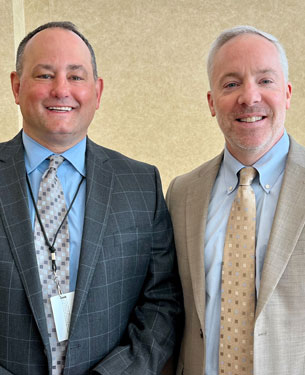
Mamaroneck Superintendent Dr. Charles Sampson and Rye Neck Superintendent Dr. Eric Lutinski
School Superintendents Share An Update on Our Public Schools
In today’s K-12 classrooms, kids are being asked to deal with the same tumultuous emotional, social, and technological issues as adults, and helping them navigate these modern challenges so that they can academically thrive is central to an educator’s mission, according to local school officials.
In an hour-long conversation, Mamaroneck Superintendent Dr. Charles Sampson and Rye Neck Superintendent Dr. Eric Lutinski discussed how their schools are evolving to support today’s learners at the April 16 meeting of the Larchmont/Mamaroneck Local Summit.
“Schools are much more dynamic now, they’re much more student-focused,” said Lutinski. “And I think one of the biggest positive shifts is taking the teacher out of the role of the sage on the stage that stands in the front and just dictates things, to more of a coach that facilitates learning.”
Rapid technological advances have upended the teacher-student relationship and challenged teachers to engage in new ways. “Google Classroom and platforms like artificial intelligence and ChatGPT and things of that nature…allow students to instantly access all of this information that traditionally the teacher possessed,” said Sampson, who started as Mamaroneck’s superintendent last November.
While the prospect of AI in the classroom raises concerns similar to the introduction of the calculator, Sampson and Lutinski want students to learn how to use the near-ubiquitous technology responsibly and ethically. They are also exploring AI’s potential to help teachers. For example, Mamaroneck has launched a pilot initiative to evaluate AI’s ability to give students early and immediate feedback on their writing, so drafts are more refined when they reach teachers’ desks.
Schools are also grappling with political polarization and the heated rhetoric amplified by social media, as well as incidents of bias. “Discussions in hallways mirror those happening around the country,” said Sampson. “We try to prevent offensive speech in the first place, and when it does occur, [we are] training staff to react in real-time.” He said the district is working to build community by giving students from different elementary schools the opportunity to meet before coming together in middle school. Lutinski added that his teachers try to turn difficult situations into opportunities to discuss historical protest movements, as well as instill the importance of civil discourse.
To create a supportive environment for learning, the districts are addressing these and other issues as part of a broader approach to student well-being. The superintendents reported higher incidences of student mental health issues such as anxiety and depression – reflecting a national trend that preceded but was exacerbated by the pandemic – which requires integrated care involving parents, teachers, and community partners, at increased levels. “It’s not just, you know, go down to the hall and make a right and then, the back room, and that’s where the psychologist is,” said Lutinski.
Additionally, Dr. Sampson discussed his district’s ongoing efforts to ensure students feel accepted and supported. One initiative, the Student Belonging and School Climate Survey, asks students to rate their engagement with the school as well as their feelings about its overall environment. Elementary school-age children participate in regular discussions on social and emotional learning and equity.
Questions over how to address the growing needs of students (and the increased physical space that is required) are addressed in the coming year’s budgets. Both districts’ proposed budgets are within their respective tax levy caps.
For Mamaroneck, which is projected to serve 5,524 students in 2024-2025 – 11 more than this year, with a significant increase in the high school population – Sampson has proposed an annual budget of $159,204,563, a 2.37% year-over-year increase, supported by a 2.59% increase over the current tax levy. According to Sampson’s office, the increase is primarily due to the rising cost of salaries, employee benefits, and supplies, including Chromebooks. The District will also make use of expiring debt to put forth a new bond proposal, which would fund $28 million in maintenance including roofing, masonry, and waterproofing repairs, and expand the cafeteria at Hommocks and kitchens at Central and Murray elementary schools.
For Rye Neck, which is projected to serve 1,461 students – 20 fewer than this year – Lutinski has proposed a budget of $51,127,223, a 2.97% increase year-over-year, supported by a tax levy increase at the local cap of 2.19%. The increase is needed to support the rising cost of staff benefits and maintain teacher-student ratios, according to his office. Also up for a vote, Proposition II proposes using the District’s capital reserve to support paving, fencing, and masonry repairs at the district’s elementary schools, a new roof for the high school gymnasium, as well as an infrastructure study for potential improvements elsewhere.
These proposals will be put before voters on May 21.
The Larchmont-Mamaroneck Local Summit is an informal community council that seeks to make a better life for the community by keeping it informed of major issues of concern. Our next meeting, on May 14 at 8 a.m. at the Westchester Jewish Center in Mamaroneck, will focus on avoiding scams and fraud. Visit the Local Summit online: https://www.localsummitlm.org/ LMC Media: https://lmcmedia.org/.
